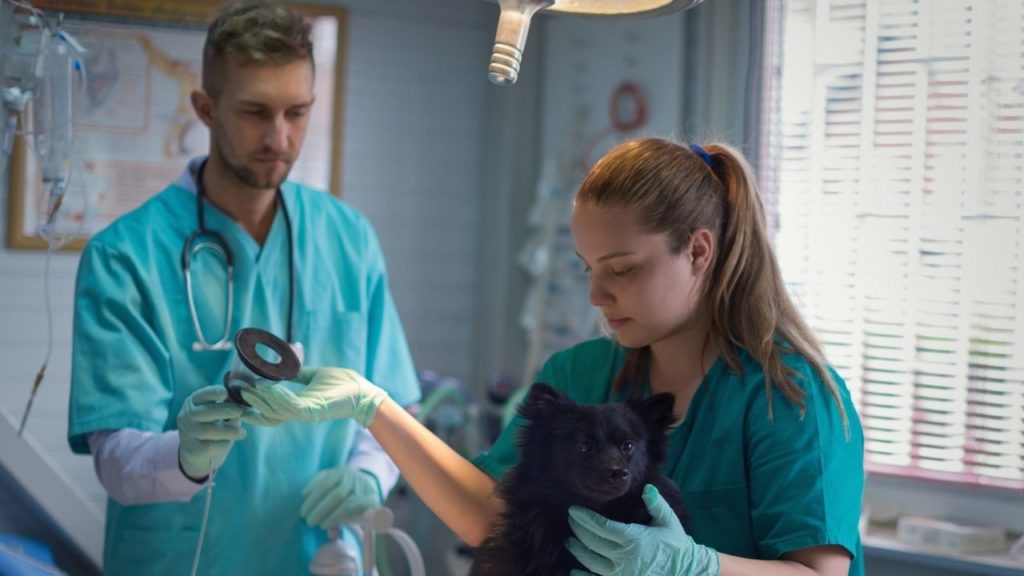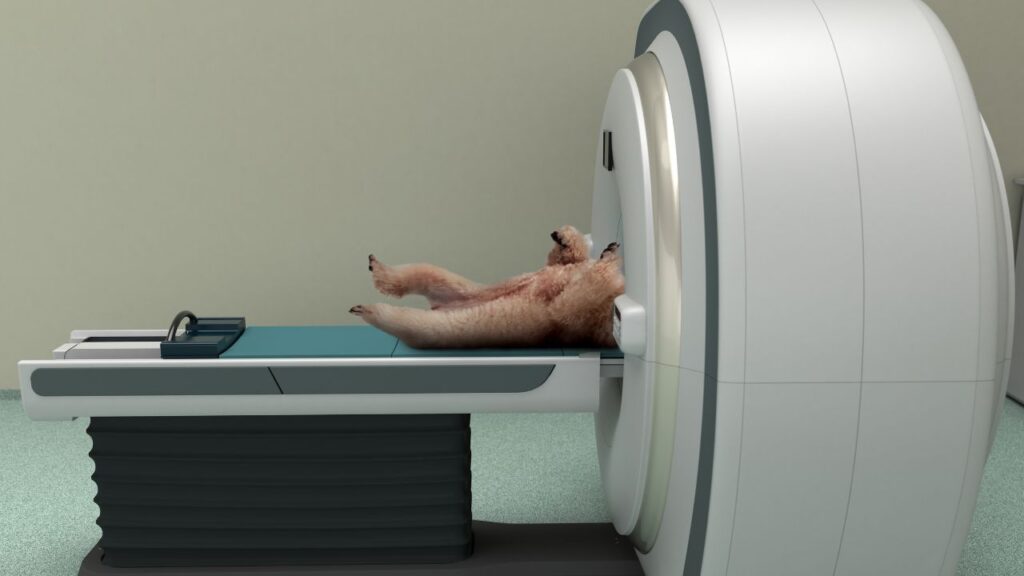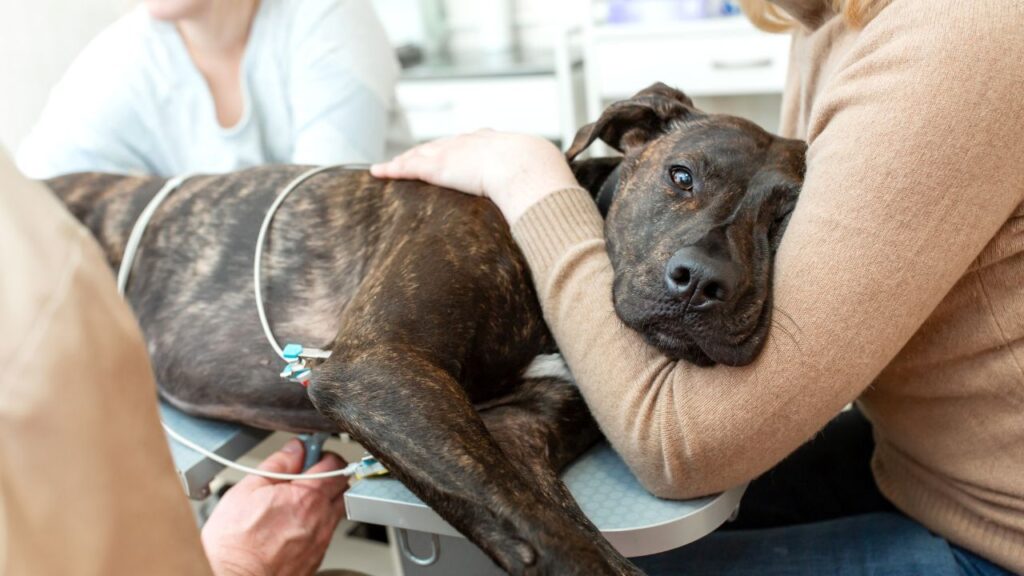EPISODE 168 | RELEASED May 23, 2022
Dog Cancer Vocab: Staging and Grading | Dr. Brooke Britton
Confused about dog cancer staging and grading, and not sure if the tests are worth the cost? Oncologist Brooke Britton explains the ins and outs.
SHOW NOTES
When your dog is diagnosed with cancer, suddenly you find yourself dropped into a world of medical jargon. Two terms you might hear are staging and grading.
In this episode, Dr. Brooke Britton explains what staging and grading are and what they can mean for your dog’s prognosis. Staging in particular can help indicate the best treatment plan for each case. Dr. Britton also goes over how to work with your vet to get the most bang for your buck – for many of us with a limited budget, we often need to pick and choose the staging tests that are likely to give us the most information and skip others to save money for cancer treatment.
Links Mentioned in Today’s Show:
[00:00:00] >> Dr. Brooke Britton: There are so many different factors which come into making these decisions, because if we spend $3,000 on staging and then someone then no longer has funds to treat, and then we recommend treatment, that kind of defeats the purpose, right?
[00:00:17] >> Announcer: Welcome to Dog Cancer Answers, where we help you help your dog with cancer. Here’s your host, James Jacobson.
[00:00:25] >> James Jacobson: Hello friend, and welcome to Dog Cancer Answers. Today, we are going to unravel everything that happens in staging a dog’s cancer. What does it mean if you hear that your dog has a stage two tumor? To help us figure this out, we’re joined by Dr. Brooke Britton. She is a veterinary oncologist, and she calls New York City home.
Dr. Britton, thank you so much for being with us today.
[00:00:50] >> Dr. Brooke Britton: Thank you so much for having me.
[00:00:52] >> James Jacobson: So what is cancer staging and why does it matter?
[00:00:57] >> Dr. Brooke Britton: Great question. Cancer staging is understanding the extent of disease within the body, so in our case, the dog or the cat’s body. And just like in people who are suspected or known to have cancer, we want to examine different bodily regions and understand how advanced the cancer is.
If there’s a origin of the cancer, a primary tumor, we want to see if it’s spread or metastasized anywhere. And then we also have staging systems for what we call more liquid tumors, which typically refers to immune system cancers like lymphoma, for example, and they have slightly different staging schemes. But staging really gives us a baseline of where we’re starting with a cancer.
[00:01:42] >> James Jacobson: So how does knowing the staging impact what kind of treatment you offer?
[00:01:47] >> Dr. Brooke Britton: Well, staging is very important to know what treatments will be most effective and likely make a difference in terms of the dog’s prognosis. For example, if we have a small, kind of solitary, what we call a solid tumor, and we don’t find any evidence that that tumor has spread – and we’ll talk about the testing that can help us determine that – but if we don’t find any evidence of spread, we may, for example, just recommend surgery to remove that tumor. And maybe the surgery alone can be curative.
The prognosis is affected the more advanced the stage is. So if we see spread, for example, to lymph nodes that drain the tumor, or we see spread to other organs, like the liver, the spleen, the lungs, something more distant as we would call it, then the stage increases and the prognosis sadly worsens. So the dogs that have more advanced stage cancers, they don’t typically tend to do as well, even with more aggressive treatments, as compared with dogs with lower stage cancers.
[00:02:50] >> James Jacobson: Are the staging numbers the same for dog cancer, pet cancer, as they are for human cancer?
[00:02:56] >> Dr. Brooke Britton: In some cases they can be very similar, but they’re often different. And the staging schemes are very different across all different tumor types for dogs.
[00:03:06] >> James Jacobson: Okay. So give me an example of the difference in like, you know, in this type of cancer, it is this type of a staging level, but in this kind, it’s this.
[00:03:14] >> Dr. Brooke Britton: Yeah. So for example, in lymphoma, is a classic five stage system. So stage one is the lowest stage, for example, where we just have one lymph node or one solitary lesion, like a skin lesion, for example, involved. Stage two is where we have multiple lymph nodes, but they’re on the same side of the diaphragm. So the diaphragm at the base of the chest kind of splits the chest and the abdomen. So if we have just lymph nodes in the neck or just lymph nodes in the groin and nowhere else, that’s a stage two.
Stage three usually means lymph nodes on both sides of the diaphragm for dogs with lymphoma. Stage four means liver and/or spleen involvement with or without lymph nodes that you can feel. And stage five would be, for example, an atypical site, like the skin or the kidney or the brain, just to where the blood involvement of the lymphoma, for the leukemic phase of lymphoma.
So that’s a very typical staging system for dogs with this cancer. And for example, with other solid tumors, we may have, you know, for example, hemangiosarcoma is a three stage cancer. This is a common tumor that we find in the spleen of dogs. Stage one is a tumor that has not ruptured. Stage two is a very, very large tumor or typically more a tumor that has ruptured and is bleeding. And stage three is where we have metastatic disease or spread to other organs, most commonly the liver or the lungs. And it varies for many different tumor types.
[00:04:44] >> James Jacobson: Okay. So sometimes it’s five, sometimes it’s three.
[00:04:48] >> Dr. Brooke Britton: Three, sometimes it’s four. So it really depends on-
[00:04:52] >> James Jacobson: It’s whatever.
[00:04:53] >> Dr. Brooke Britton: Yeah, it really depends on the particular tumor. And the World Health Organization has a staging schemata which we adhere to. So a lot of these stages for different cancers are things that people can look up and reference. They’re pretty well-defined.
[00:05:09] >> James Jacobson: But a rule of thumb across the board with dogs or people is the higher the number, the worse it is.
[00:05:15] >> Dr. Brooke Britton: That’s right.
[00:05:15] >> James Jacobson: The lower the number, the better it is.
[00:05:17] >> Dr. Brooke Britton: Usually.
[00:05:18] >> James Jacobson: Okay.
[00:05:18] >> Dr. Brooke Britton: Yep. That’s usually right.
[00:05:19] >> James Jacobson: Okay. But five is the most that you encounter with, and that’s with lymphoma.
[00:05:23] >> Dr. Brooke Britton: Typically, yeah. With lymphoma.
[00:05:24] >> James Jacobson: None of these six or seven stage tumors. So in terms of, of getting this number, that comes back with the pathology report, I mean, the pathologists are the ones who stage it.
[00:05:35] >> Dr. Brooke Britton: Actually, no. That is grade. So usually the pathologist will provide a grade of the tumor by looking at a tumor sample under the microscope, usually via surgical sample or a tiny little punch sample or a true cut sample, needle sample. So they will provide a grade or degree of aggressiveness of the tumor. And there are multiple different grades across tumors.
Usually grade one, two, or three. Low, medium, high. Staging is the extent of the tumor within the body. So that’s something that we, as the medical oncologists, determine, and the types of tests that we do for staging are variable. We usually will get baseline blood work to look at the red blood cells, the white cells, the platelets, kidney and liver values, electrolytes.
We’ll do imaging, typically of the chest and the abdomen for many tumors. Usually we’re doing both, but sometimes it’s appropriate to only do one or the other, depending upon the cancer. And again, we’re looking for lymph node involvement, evidence of the other organ involvement such as nodules in the lungs or nodules in the spleen, the liver, things like that.
Sometimes we will also do, if we’re suspicious of central nervous system involvement, maybe a spinal tap to look for cancer cells in the spinal fluid. Sometimes we’ll do a bone marrow aspirate to look for cancer cells in the bone marrow. So there are many different tests that we can do. If we want to be very advanced, sometimes we’ll do a more advanced imaging test like a CT scan or an MRI, just like in people. That gives a higher resolution picture of where lesions might be, and also allows us, in the case of CT, to look at bone very carefully. There are some tumors that will spread to bone, and so that test is very helpful in staging those tumors.
[00:07:26] >> James Jacobson: So what is the difference in terms of understanding a cancer from the grading to the staging? So the grading is something that the pathologist assesses and there are only a few choices.
[00:07:39] >> Dr. Brooke Britton: Correct.
[00:07:39] >> James Jacobson: Does that also have a variable number like staging or is it just like one, two, and three?
[00:07:43] >> Dr. Brooke Britton: Usually it’s one, two, and three or low, intermediate, and high.
[00:07:47] >> James Jacobson: Okay.
[00:07:48] >> Dr. Brooke Britton: And sometimes it’s just low grade or high grade. Umm for example, with lymphoma, if we take a biopsy of a lymph node or an organ with lymphoma in it, usually it’s a high grade lymphoma or low grade lymphoma. Occasionally we have the intermediate grade lymphomas. But those are the types of terminology that you would encounter when you’re talking about grade.
What I would say is that if we have a high grade tumor, usually we’re more concerned about a high grade tumor in terms of the potential for that tumor to come back and/or to spread or metastasize. But maybe we have a high grade tumor that we caught early. Maybe it’s still small. Maybe it is a low stage, meaning it hasn’t spread anywhere, it hasn’t metastasized. And so we could still have a good prognosis or a good outcome even with a high grade tumor if we catch it early and it’s of low stage.
[00:08:39] >> James Jacobson: Okay. So you can have a high grade, low stage and conversely you can have-
[00:08:44] >> Dr. Brooke Britton: Absolutely.
Conversely, you can have a tumor that maybe is a higher stage, you know, it’s able to be technically taken out with surgery, maybe something small, but if it’s already spread, we see this at many times in anal sac adenocarcinomas, where we may find a small tumor within the anal sac, but then we have a really big lymph node inside the abdomen because it’s already spread, or we have other metastatic lesions, even though the primary is very tiny.
So in that case, you know, even if the tumor is deemed low grade or intermediate grade, the metastatic presence kind of trumps the grade of that tumor, if that makes sense. The higher stage is always going to be more concerning because it’s already shown that the tumor can move on to other areas, and by defacto that means that it will be more difficult to treat typically.
[00:09:40] >> James Jacobson: So, based on what you said earlier, it sounds like there are a variety of different tests depending on the type of cancer that you would use to determine the stage.
[00:09:49] >> Dr. Brooke Britton: Yes. And not every test is going to be performed in every case. You know, for example, bone marrow aspiration. Typically we’re looking for tumor cells in the bone marrow with immune system cancers or what we call round cell tumors versus solid tumors like carcinomas or sarcomas.
We wouldn’t expect to find those in the bone marrow. So we’re not doing bone marrow aspirates typically on those dogs, but we may be doing other tests like CT scan on those dogs that may not help us as much in the dog with lymphoma. So the tests can vary depending upon what cancer we’re dealing with.
[00:10:25] >> James Jacobson: Dr. Britton, I want to take a break right here, we gotta pay some bills, but more with Dr. Brooke Britton right after this.
We are back with Dr. Brooke Britton talking about staging and your dog’s cancer. So all of these tests sound kind of expensive. What if I have-
[00:10:46] >> Dr. Brooke Britton: Expensive? [laughs]
[00:10:47] >> James Jacobson: What if I have limited funds and I really can’t do every test under the sun to, to figure out the staging. What do I do then?
[00:10:54] >> Dr. Brooke Britton: That’s a great question, because we want to have as much information as possible to help us make the best clinical decisions. But yet, reality always comes into play. And there are so many different factors which come into making these decisions because if we spend $3,000 on staging and then someone then no longer has funds to treat and we recommend treatment, that kind of defeats the purpose. Right?
[00:11:18] >> James Jacobson: Right.
[00:11:18] >> Dr. Brooke Britton: So oftentimes we’ll look at a specific tumor – if we know what tumor type we’re dealing with at the outset, we’ll look at that tumor and say, where is it most likely to spread? How is it most likely to spread, by the lymphatic system, by the blood, hematogenously as we call it. What are the most common organ systems that this would spread to? And we know that maybe a small percent over here, small subset, may metastasize more widely to, you know, other sites maybe that we would need other tests for.
But the chance of that is small enough that we want to put our resources to the tests that are going to give us the greatest yield. Where are we most likely to see spread? In the lymph node and the lungs? Well then maybe we do a lymph node aspirate and chest x-rays as opposed to a CT scan, which requires anesthesia and is much more expensive. And we start there and we see where we are.
There’s always sort of the medical ideal, and then there’s what we, you know, what is practical and what can give us the information that we need. And before I run a test or recommend a test, I’m always asking myself, is it going to make a difference in what I do? You know, if we want a really detailed, really nice looking picture, great, everyone wants that. But really is that test, especially if it’s much more invasive, much more expensive, or, you know, basically much more labor intensive to do, is it really going to change my clinical decision-making going forward?
Sometimes it does. And then if I say, look, I really would prefer to do this, and someone says, look, I can’t do that, then that’s okay. And then we have to explain to people, okay, well, we could do this, it gives us a little bit less information, but basically I’m going to have a blueprint to treat your dog and, you know, we can always re-examine other testing, other imaging going forward.
So these are conversations I constantly have with people, because it’s not just the baseline, right? It’s setting people up for the journey that is treatment and reassessment, and often we’re developing long relationships over time. So we don’t want to, you know, drop $15 K at the outset if we can help it, you know, on things that may or may not move the dial down the line.
[00:13:27] >> James Jacobson: So elaborate a little bit more on those conversations. If you were my vet, Dr. Britton, how would that conversation go?
[00:13:34] >> Dr. Brooke Britton: Well, depending upon the cancer.
[00:13:38] >> James Jacobson: Right. You get, pick a cancer. Pick a cancer.
[00:13:40] >> Dr. Brooke Britton: Always the caveat.
[00:13:41] >> James Jacobson: Yeah.
[00:13:42] >> Dr. Brooke Britton: So let’s, let’s say lymphoma. Lymphoma is a good example, right? And I have a Golden Retriever who comes in, they’re a ten-year-old Golden, they feel fine, but their person noticed big lymph nodes while they were petting them a week ago, or the groomer noticed big lymph nodes a week ago. And they go to their primary vet. They get a lymph node aspirate, and it comes back as lymphoma, which typically most of the times we can diagnose off a simple needle aspirate. Sometimes we need more.
So do I then need to recommend going in and taking a biopsy of that lymph node? Usually not. There are many different types of lymphoma, but the biopsy, in many cases, won’t change at least what we do initially. I ideally recommend blood work, chest x-rays, ultrasound. I usually save a bone marrow aspirate for dogs that tend to have significant blood work abnormalities where I’m worried about bone marrow involvement.
There is a testing called phenotyping or flow cytometry that we can look at to see the type of lymphoma. Very briefly, dogs fall into usually two categories, one of two categories, B or T cell lymphoma. Doing that test gives me a lot more nuance in terms of how to treat, but that test can be hundreds of dollars.
And so if someone says, look, I, you know, that’s not in my wheelhouse right now, but we can work just off a lymph node aspirate. You know, it’s not ideal not to have those pieces of the puzzle, but you know we start to kind of go through which of the tests gives us the most information to allow me to make those types of decisions and hopefully get the best outcome for their pet, and which of the tests are kind of not quite as important.
None of them are truly superfluous, but sometimes we do have to make those trade-offs between what do we think is going to give us the most information right now when we need it and what would be ideal.
[00:15:35] >> James Jacobson: So are there some instances where you just skip the additional tests and skip the staging and just go, well, we’re going to just go with what we have because we have limited funds to figure out the staging.
[00:15:46] >> Dr. Brooke Britton: Yeah. Sometimes I do make that decision, and where it differs is that in an immune system cancer like lymphoma, for example, many lymphomas are what we would call systemic or body-wide at diagnosis. So the assumption is almost there’s probably somewhere else that’s involved as opposed to just the external lymph nodes, or at least there is a good chance of that.
And so sometimes, but not always, doing the staging does change what you do. But if we have a diagnosis of lymphoma, and we know that that disease is usually aggressive and progresses rapidly, then putting resources towards treatment, even with no further information, is sometimes the trade-off that we make because treatment is long and it adds up.
It can be very expensive if we do kind of a more intensive course of chemotherapy, which is typically the recommendation for that disease. If we have a tumor that we’re concerned may have spread, or is very aggressive, high grade on pathology, and we decide not to stage for whatever reason, the concern is that maybe we recommend treatments that might not be ideal.
Like maybe we say, okay, well, we’ll take that tumor off because right now we have a tumor and it needs to come off, and then we don’t stage and then we find out it’s high grade and maybe that tumor has spread and we just don’t know it. And maybe we start treatments with best intentions, but if that tumor is very advanced stage, we may be fighting against a very poor prognosis.
And in some cases, people may say, wow, I really wish that I would’ve known, you know, that this tumor was kind of either too far gone or far down along the road. You know, people sometimes will use the staging to make decisions. Do they feel like it’s worth that investment. And I’m not just talking about financial, I’m talking about the physical investment of getting their dog to treatments, emotional investment of going through treatment.
So sometimes the staging is really helpful, um, many times, but, um, again, I try to tailor it to what people are able to do because ultimately if they want to treat a cancer, putting money towards treatment is obviously what we prefer to do so they can, they can get the treatment that they need.
[00:18:05] >> James Jacobson: So do you sometimes see people who when, after you stage a tumor say, okay, now that I know the staging, I really don’t want to pursue treatment?
[00:18:16] >> Dr. Brooke Britton: Yes. Yeah. Sometimes people do have that baseline and let’s say the staging is – let’s say hemangiosarcoma is an excellent example. Splenic hemangiosarcoma. And oftentimes those dogs sadly will come in with a bleeding tumor. It’s life-threatening. They need to have their spleen taken out and they do a splenectomy, and usually we’ll biopsy the liver because that’s a common metastatic site, if the chest x-rays are clean. If there are nodules in the chest already, oftentimes we may not even go to surgery. Let’s um, let’s say the liver comes back and that’s metastatic, that’s stage three. And we know that even with very aggressive treatments, while I have seen a subset of dogs do far better than expectation, typically the median, meaning about half of dogs gets to this point or longer, is three to four months with very aggressive, you know, chemo and other treatments.
It doesn’t mean it’s not worth considering them, but for some people they may say, look, you know, I’m glad I did the surgery because the life-threatening issue is over, my dog feels much better now. But if we’re looking at under six months of life despite everything that we try, on average or statistically, they may not want to go forward and do something like chemotherapy.
And the important thing is that we try to get as much information and give as much information as we can so that the person who is looking out for the best interests of their pet, their companion, you know, they’re going to be able to feel as comfortable as possible under the circumstances making that decision, whatever it is.
And many times the staging is a very important part of that. And it allows me to give statistics, you know, I can cite literature and my own clinical experience that says based on this stage and your dog’s presentation, this has been my experience, and this is what’s been published in terms of what to expect for outcome. So people have a better idea of how their dog might do.
[00:20:17] >> James Jacobson: So, is that something that is common that, I mean, basically is going through the expense and process of staging a tumor useful for other dogs, useful for oncology in general, because you’re giving more information to the field?
[00:20:34] >> Dr. Brooke Britton: Oh yes, absolutely. So when we know the stage of tumor that we’re dealing with, we can publish papers that cite that stage and say, based on that, we did X treatment, and this is how those dogs did. Or maybe we have a treatment that we institute across all stages and say, does that treatment actually make a difference at all, or does it make a difference for dogs within a particular stage category versus another?
If we have data that we put out there and we don’t do full staging, you know, maybe the statistics indicate that those dogs didn’t do very well with X treatment, but maybe all those dogs had really advanced stage and we just didn’t know it. And so we were sort of, I hate to use this phrase, but fighting a bit of an uphill battle, and people might say, whoa, those dogs do terribly, you know, why should we even do that?
And it’s like, well, you know, then there’s a little bit of bias in there, right? Because maybe those dogs were all very end-stage dogs and we just didn’t know because we didn’t do the tests. So the tests have a lot of value. It’s not just, you know, oh, we should do this because the textbook says complete staging is important.
Complete staging is really important for us to know the lay of the land, so to speak. There are times when we don’t need to do every single test and a good oncologist will be able to explain that clearly to a person and why certain tests are important and why others are not as important, even if they’d still prefer them.
Ultimately, of course, one has to meet in the middle. You know, if someone has finite resources or doesn’t want to do something for whatever reason, we have to work with that, and we do. But it’s important to explain at least to people why, even if they elect not to do it or they can’t do it, why it’s important.
[00:22:23] >> James Jacobson: Well, I’m just intrigued with this concept of disseminating this information. You said that you could write a paper, which sounds like a lot of work, but is there a more – I mean, right? – is there a more useful, accessible way for oncologists to share the staging and the protocol so that it becomes more readily available to other oncologists?
[00:22:45] >> Dr. Brooke Britton: That is how we do it. We write academic papers that are peer-reviewed. Yeah. So we all, we all read each-
[00:22:52] >> James Jacobson: There’s no database that you guys submit to. Okay.
[00:22:55] >> Dr. Brooke Britton: Sometimes there are, across universities or larger private practice groups there can be databases of clinical trials data.
[00:23:03] >> James Jacobson: That’s what I was getting at.
[00:23:03] >> Dr. Brooke Britton: So you can sort of run like more nationwide or region wide statistics on these things. So, yeah, and those databases are extant and they are, you know, active, people actively share information into them and correlate that data um, with outcomes.
And then there are, you know, just random papers out in the general world, the body of literature, so to speak, that we are constantly reading, reviewing, writing to help each other practice evidence-based medicine, not just like, oh, we assume this is going on, that’s probably what’s happening. You know, we want to have as much evidence basis for doing what we do.
[00:23:41] >> James Jacobson: Awesome. Well, I figure that may factor into someone’s decision to, to spend the extra money to do the full staging, because while it may not benefit my own dog, it could benefit other dogs and the field in general.
[00:23:55] >> Dr. Brooke Britton: True. So for example, if we do the staging on a hypothetical dog and that hypothetical dog has very advanced disease and their person says, well, look, I, I just don’t know if I’m gonna want to treat, that’s absolutely fair.
But someone might say, no, despite this, I still want to treat, and one could make a case for the fact that those cases are the ones that really need to be put out there, not to pressure people into treating, but the people that do want to take it a step further, even when finding out quote unquote “bad news,” those dogs, and identifying the dogs that do really, really well, despite the odds. You know, just like in human medicine, why do we have some people that have dire cancers, but yet they’re living 10, 15, 20, 30 years down the road doing better than anyone expected or than the doctors ever told them that, that they could.
Those cases are really important too. And the more we know about, realistically, what the baseline is, well where we’re starting from, it can be really helpful when we’re sharing this data. The more we know, the more we can inform the next decision for the next dog. So that’s exactly right to your point.
[00:25:10] >> James Jacobson: That’s awesome.
Dr. Britton, thank you so much. You’ve done such a good job of explaining this rather complex area of staging. You’re very articulate. Will you come back again and talk to us more about dog cancer sometime?
[00:25:20] >> Dr. Brooke Britton: I would love to, I like to talk, as you can see, so I would love to.
[00:25:26] >> James Jacobson: Well, we like to listen and we like to learn from, from great oncologists like yourself.
Thank you so much for being with us today.
[00:25:33] >> Dr. Brooke Britton: Thank you so much for having me.
[00:25:37] >> James Jacobson: Wow. There is so much to know when it comes to staging. And, uh, we are so grateful for Dr. Britton joining us today. And we’re grateful for you for hitting that play button. If you have a dog with cancer, staging is just one of the things that you need to know about.
There’s a lot more on our website at dogcanceranswers.com. I hope you will check it out where you can listen to and watch all of our previous episodes and read the show notes. That’s at dogcanceranswers.com. If today’s show was helpful, I hope you will do us a favor and tell a friend about Dog Cancer Answers. And tell your veterinarian as well, because the more people who know about the show, the more dogs we can help.
I’m James Jacobson, from all of us here at Dog Podcast Network, thank you for joining us today, and please stay tuned for shows that are also on DPN that you can listen to now.
[00:26:36] >> Announcer: Thank you for listening to Dog Cancer Answers. If you’d like to connect, please visit our website at dogcanceranswers.com or call our Listener Line at (808) 868-3200. And here’s a friendly reminder that you probably already know: this podcast is provided for informational and educational purposes only.
It’s not meant to take the place of the advice you receive from your dog’s veterinarian. Only veterinarians who examine your dog can give you veterinary advice or diagnose your dog’s medical condition. Your reliance on the information you hear on this podcast is solely at your own risk. If your dog has a specific health problem, contact your veterinarian.
Also, please keep in mind that veterinary information can change rapidly, therefore, some information may be out of date. Dog Cancer Answers is a presentation of Maui Media, in association with Dog Podcast Network.
Hosted By
SUBSCRIBE ON YOUR FAVORITE PLATFORM
Topics
Editor's Picks
CATEGORY











